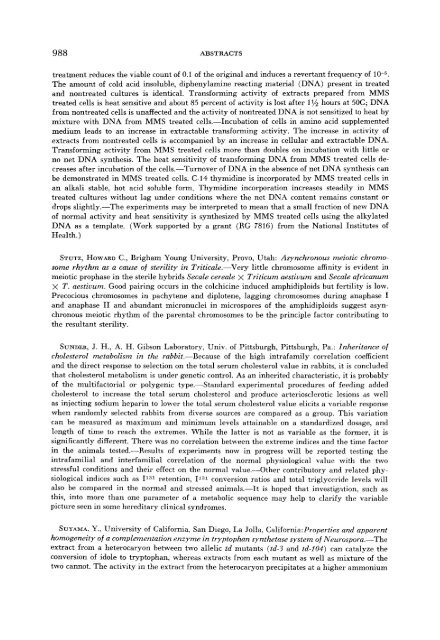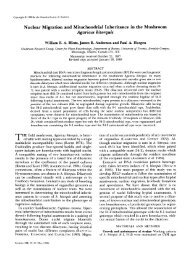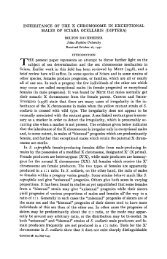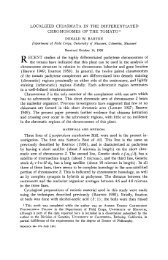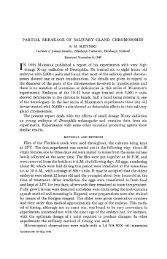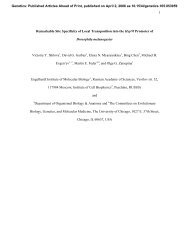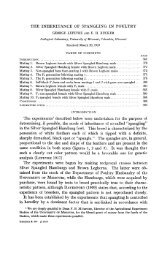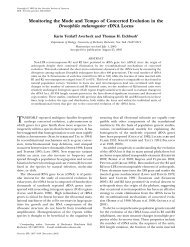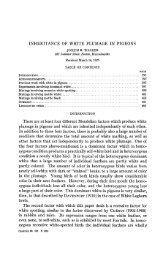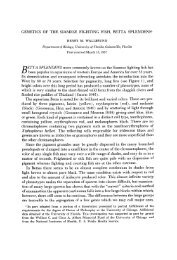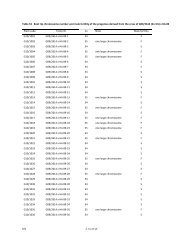abstracts of papers presented at the 1962 meetings - Genetics
abstracts of papers presented at the 1962 meetings - Genetics
abstracts of papers presented at the 1962 meetings - Genetics
Create successful ePaper yourself
Turn your PDF publications into a flip-book with our unique Google optimized e-Paper software.
988 ABSTRACTS<br />
tre<strong>at</strong>ment reduces <strong>the</strong> viable count <strong>of</strong> 0.1 <strong>of</strong> <strong>the</strong> original and induces a revertant frequency <strong>of</strong><br />
The amount <strong>of</strong> cold acid insoluble, diphenylamine reacting m<strong>at</strong>erial (DNA) present in tre<strong>at</strong>ed<br />
and nontre<strong>at</strong>ed cultures is identical. Transforming activity <strong>of</strong> extracts prepared from MMS<br />
tre<strong>at</strong>ed cells is he<strong>at</strong> sensitive and about 85 percent <strong>of</strong> activity is lost after 1 '/e hours <strong>at</strong> 50C; DNA<br />
from nontre<strong>at</strong>ed cells is unaffected and <strong>the</strong> activity <strong>of</strong> nontre<strong>at</strong>ed DNA is not sensitized to he<strong>at</strong> by<br />
mixture with DNA from MMS tre<strong>at</strong>ed cells.-Incub<strong>at</strong>ion <strong>of</strong> cells in amino acid supplemented<br />
medium leads to an increase in extractable transforming activity. The increase in activity <strong>of</strong><br />
extracts from nontre<strong>at</strong>ed cells is accompanied by an increase in cellular and extractable DNA.<br />
Transforming activity from MMS tre<strong>at</strong>ed cells more than doubles on incub<strong>at</strong>ion with little or<br />
no net DNA syn<strong>the</strong>sis. The he<strong>at</strong> sensitivity <strong>of</strong> transforming DNA from MMS tre<strong>at</strong>ed cells de-<br />
creases after incub<strong>at</strong>ion <strong>of</strong> <strong>the</strong> cells.-Turnover <strong>of</strong> DNA in <strong>the</strong> absence <strong>of</strong> net DNA syn<strong>the</strong>sis can<br />
be demonstr<strong>at</strong>ed in MMS tre<strong>at</strong>ed cells. C-I4 thymidine is incorpor<strong>at</strong>ed by MMS tre<strong>at</strong>ed cells in<br />
an alkali stable, hot acid soluble form. Thymidine incorpor<strong>at</strong>ion increases steadily in MMS<br />
tre<strong>at</strong>ed cultures without lag under conditions where <strong>the</strong> net DNA content remains constant or<br />
drops slightly.-The experiments may be interpreted to mean th<strong>at</strong> a small fraction <strong>of</strong> new DNA<br />
<strong>of</strong> normal activity and he<strong>at</strong> sensitivity is syn<strong>the</strong>sized by MMS tre<strong>at</strong>ed cells using <strong>the</strong> alkyl<strong>at</strong>ed<br />
DNA as a templ<strong>at</strong>e. (Work supported by a grant (RG 7816) from <strong>the</strong> N<strong>at</strong>ional Institutes <strong>of</strong><br />
Health.)<br />
STUTZ, HOWARD C., Brigham Young University, Provo, Utah: Asynchronous meiotic chromosome<br />
rhythm as a cause <strong>of</strong> sterility in Triticale.-Very little chromosome affinity is evident in<br />
meiotic prophase in <strong>the</strong> sterile hybrids Secale cereale x Triticum aestiuum and Secale africanum<br />
x 2'. aestiuum. Good pairing occurs in <strong>the</strong> colchicine induced amphidiploids but fertility is low.<br />
Precocious chromosomes in pachytene and diplotene, lagging chromosomes during anaphase I<br />
and anaphase I1 and abundant micronuclei in microspores <strong>of</strong> <strong>the</strong> amphidiploids suggest asynchronous<br />
meiotic rhythm <strong>of</strong> <strong>the</strong> parental chromosomes to be <strong>the</strong> principle factor contributing to<br />
<strong>the</strong> resultant sterility.<br />
SUNDER, J. H., A. H. Gibson Labor<strong>at</strong>ory, Univ. <strong>of</strong> Pittsburgh, Pittsburgh, Pa.: Inheritance <strong>of</strong><br />
cholesterol metabolism in <strong>the</strong> rabbit.-Because <strong>of</strong> <strong>the</strong> high intrafamily correl<strong>at</strong>ion coefficient<br />
and <strong>the</strong> direct response to selection on <strong>the</strong> total serum cholesterol value in rabbits, it is concluded<br />
th<strong>at</strong> cholesterol metabolism is under genetic control. As an inherited characteristic, it is probably<br />
<strong>of</strong> <strong>the</strong> multifactorial or polygenic type.-Standard experimental procedures <strong>of</strong> feeding added<br />
cholesterol to increase <strong>the</strong> total serum cholesterol and produce arteriosclerotic lesions as well<br />
as injecting sodium heparin to lower <strong>the</strong> total serum cholesterol value elicits a variable response<br />
when randomly selected rabbits from diverse sources are compared as a group. This vari<strong>at</strong>ion<br />
can be measured as maximum and minimum levels <strong>at</strong>tainable on a standardized dosage, and<br />
length <strong>of</strong> time to reach <strong>the</strong> extremes. While <strong>the</strong> l<strong>at</strong>ter is not as variable as <strong>the</strong> former, it is<br />
significantly different. There was no correl<strong>at</strong>ion between <strong>the</strong> extreme indices and <strong>the</strong> time factor<br />
in <strong>the</strong> animals tested.-Results <strong>of</strong> experiments now in progress will be reported testing <strong>the</strong><br />
intrafamilial and interfamilial correl<strong>at</strong>ion <strong>of</strong> <strong>the</strong> normal physiological value with <strong>the</strong> two<br />
stressful conditions and <strong>the</strong>ir effect on <strong>the</strong> normal value.-O<strong>the</strong>r contributory and rel<strong>at</strong>ed physiological<br />
indices such as Ix31 retention, 1131 conversion r<strong>at</strong>ios and total triglyccride levels will<br />
also be compared in <strong>the</strong> normal and stressed animals.-It is hoped th<strong>at</strong> investig<strong>at</strong>ion, such as<br />
this, into more than one parameter <strong>of</strong> a metabolic sequence may help to clarify <strong>the</strong> variable<br />
picture seen in some hereditary clinical syndromes.<br />
SUYAMA.<br />
Y., University <strong>of</strong> California. San Diego, La Jolla. California: Properties and apparent<br />
homogeneity <strong>of</strong> a complement<strong>at</strong>ion enzyme in tryptophan syn<strong>the</strong>tase system <strong>of</strong> Neurospora.-The<br />
extract from a heterocaryon between two allelic td mutants (td-3 and td-104) can c<strong>at</strong>alyze <strong>the</strong><br />
conversion <strong>of</strong> idole to tryptophan, whereas extracts from each mutant as well as mixture <strong>of</strong> <strong>the</strong><br />
two cannot. The activity in <strong>the</strong> extract from <strong>the</strong> heterocaryon precipit<strong>at</strong>es <strong>at</strong> a higher ammonium


